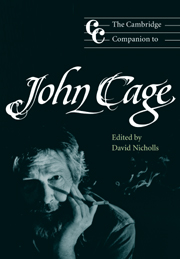Book contents
11 - Cage and high modernism
from Part III - Interaction and influence
Published online by Cambridge University Press: 28 September 2011
Summary
During a lively correspondence with John Cage that took place around 1950, Pierre Boulez recognized parallels between his own development of integral serialism and the systematic procedures Cage used in the Music of Changes (1951). Boulez noted that Cage “has been working on setting up structural relations between different components of sound, and for this he uses tables which organize each component into parallel but autonomous distributions. The tendency of these experiments by John Cage is too close to my own for me to fail to mention them” (Boulez 1952a, p. 135). At that time, with the composition of Livre pour quatuor (1949), Polyphonie X for eighteen instruments (1951), and Structures for two pianos (1951–52), Boulez was intensely pushing the limits of the serial system. He saw similarities between the development of total serialism and Cage's focus on the “individuality of sound,” particularly because the latter took into account all the attributes of sound: pitch, amplitude, timbre, and duration. Cage had reached a crucial point in the evolution of his musical style and aesthetics, the beginning of a life-long preoccupation with chance and indeterminacy. Yet, despite the fact that, on the surface, the determinism of total serialism seems diametrically opposed to Cage's aesthetic agenda, Boulez and Cage had much in common. The relationship among the two composers is symptomatic of a larger historical issue, namely, Cage's place within the development of musical modernism after the Second World War. We shall return to this broader context after examining the evolution of Cage's musical style during the late 1940s and 1950s.
- Type
- Chapter
- Information
- The Cambridge Companion to John Cage , pp. 186 - 213Publisher: Cambridge University PressPrint publication year: 2002
- 4
- Cited by



